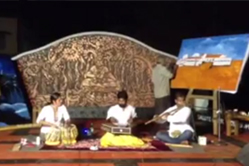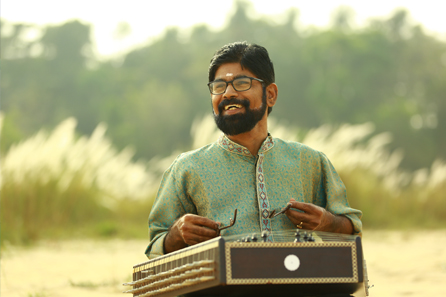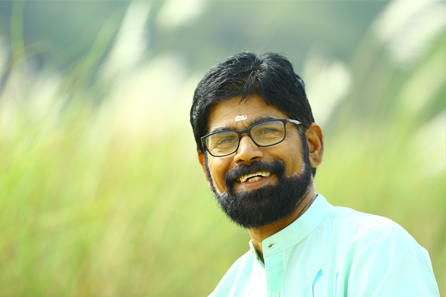

SANTOOR



The music of Santoor has its origin in the ancient valley of Kashmir in India. The Santoor is a type of Veena or string Instrument whose original name was Shata-Tantri Veena, meaning ‘100 strings’ in Sanskrit, crediting the hundred strings that make this instrument unique from the rest. The instrument got its present name because of the Persian language influence in India making sure that the poetic essence of the instrument stays alive. In its early stages, Santoor was a hollow box on top of which there are 25 bridges and each bridge having four strings attached. Two wooden mallets are used to play this instrument. Santoor has been played for many centuries in Kashmir, especially as a part of Sufiana Mausiqi or Sufi music which is connected closely to Sufi philosophy. It is usually played as a complimentary instrument for singers but also holds its ground as a solo instrument. Till 1950s, the instrument was only used in Sufiana music and no one from outside Kashmir had heard the name Santoor. But similar instruments are found in different parts of the world in different names like Yang Quin in China, Cimbale in Central Asia, Santoori in Greece, Hackbret in Europe, Hammer-Dulcimer in America and so on. Some believe that the Santoor originated in Iran, but according to Indian Musicologists and ancient Sanskrit scriptures, Santoor is an Indian instrument.


The future of Santoor changed tremendously in the 1950s when Pandit Uma Dutt Sharma, a versatile musician and vocalist saw the instrument in Kashmir and thought of introducing Santoor to Indian Classical Music. He did extensive research on Santoor and started teaching his son, Pandit Shivkumar Sharma the intricacies of the instrument, which was never before used in Indian Classical Music. His son was thus able to become a renowned Santoor master. Pandit Shivkumar Sharma carried on his father’s experiments on Santoor for many years improving its tonal quality, playing technique, sitting posture and helped enhance its repertoire by bringing a varied emotional and spiritual expression to the instrument. If previously the Santoor was only made in Kashmir, it is now made by expert craftsmen in Mumbai, Delhi, Kolkata, Punjab and Varanasi with the modifications made by Pandit Shivkumar Sharma, which is presently regarded as the standardized form of this instrument. Pandit Shivkumar Sharma was thus able to give Santoor its own distinct character in Indian Classical Music today. His son, Pandit Rahul Sharma introduced Santoor to world music with his fusion performances and collaborations with international jazz, pop artists.


HARI


Alankode Haridas is a Santoor Artiste from Kerala, who began his journey into music
in 1981, by learning Violin under Sri A. P Bharghavan in Kuttipuram. For the next 12
years, he mastered the art of violin and took a keen interest in Hindustani Classical
Music listening to various musicians under the guidance of his Violin Teacher.
Haridas heard the sound of Santoor for the first time while listening to the thematic
album ‘Call of the Valley’. He became fascinated by the sound and it gave him a fresh
outlook into classical music. After being mesmerised by the way Pandit Shivkumar
Sharma plays, he bought his own Santoor from Delhi and for six months tried to
understand the intricacies of the instrument and play it in his own way.
Things took a turn in 1992, when Alankode Haridas was able to meet Pandit
Shivkumar Sharma and seek his guidance in learning the art of Santoor in Kerala
when he visited Kottakal for a concert. At the very first lesson, Haridas was able to
impress Pandi Shivkumar Sharma who took him on as his student of Santoor. He
practiced under the Pandit in the coming years, travelling to Bombay whenever
possible and is presently one of Pandit Shivkumar Sharma’s disciple and a pioneer of
Santoor in Kerala.


With the guidance of Pandit Shivkumar Sharma, Haridas was able to craft his own name as a Santoor Artiste by incorporating the essence of Kerala music into Santoor for the past 25 years. With over 1500 concerts in Kerala and many more abroad, Haridas was able to popularise the instrument in South India. He continuously strives to instil Santoor and Hindustani Classical Music into the hearts of the youth by demonstrating and taking lessons on Santoor for students. He plays Santoor as a form of meditational, devotional music for people looking to heal their souls as well as for various film and album songs, bringing more popularity to the sound. Along with his son Sreerag, Haridas has held many concerts that enthral the audience with the magic of Santoor under the name Hari_Sree

STRINGS

-
Neuro Linguistic Programming (NLP) sessions, Prakash, NLP master, Trivandrum
-
Pranic Healing Meditation with Smt Vrinda, Master Pranic Healer, Trivandrum
-
Music Therapy Sessions for differently abled persons with different health care institutions and special schools
-
Yoga Meditation sessions with Sivananda Yoga Centres in Kerala, Delhi, Chennai, Bangalore
-
Art of Living Meditation in Bangalore Headquarters, Abu Dhabi, Sharjah.
-
Soorya Festival, Trivandrum
-
Swaralaya Festival, Palakkad And Trivandrum
-
Kerala Sangeet Nataka Academy, Thrissur, Kottayam And Palakkad
-
Sangeet Natak Akademi, Delhi
-
SPICMACAY, Kozhikode
-
Kala Kendra, Kolkata
-
Chinmaya Naada Bindu Gurukala, Pune
-
AOL Centre, BAnglore
-
Kalagramam Mahe
-
Kendriya Vidyalaya, Kasargod
-
Chembai Music College, Palakkad
-
Brannan College Thalasseri
-
Goethe Zentrum, Trivandrum
-
Calicut Medical College
-
UAE
-
Mangalore
-
Chennai
-
Mumbai,
-
Puttaparthi


-
Veena:AnanthapadmanabhanAnand koushik
-
Sitar:PaulsonMurali
-
Mandolin:Arvind Bharghava, Chennai
-
Mohananveena:Murali
-
Flute:Raghunadan, RisonHimanshu Nanda, Nandakumar
-
Violin:BalabhaskarSurendranVayala RajendranSreekkuttan
-
Tabla:Ustad Fayyaz Khan Sahib(Late), DelhiAnubrata Chatterjee, KolkataArindam Chakraborthy, KolkataNilesh Shinde, PuneThamaghna Chakraborthy, KolkataRajesh Dhavle, ChennaiRohit Kulkarni, PuneSandeepan, DubaiRetnasree Iyer, KeralaMuthu Kumar, BangaloreShaheen P Naser, KeralaDean Mohan, Kerala
-
Associations with Films and AlbumsBombay RaviRamesh NarayanBerny-IgnatiusT S RadhakrishnanRajesh CherthalaPrakash UlliyeriFr Paul Poovathinkal


-
Hari-Sree
Santoor Jugalbandi with son Sreerag Hari -
Visranthi (Santoor- Tabla)
For meditation, music therapy, stress management and cultural events -
Vilayanam (Santoor- Violin- Tabla- Mrudangam)
For reception and get-togethers -
Raganila (Santoor- Flute- Tabla)
Romantic ragas for full moon night -
Transmit (Santoor- Tabla)
Ideal for lecture demonstration for students -
Raga Chitram
Santoor and Painting Jugalbandi with brother Mohan Alankode -
Raga Madhavam
Thematic Jugalbandi of Santoor and Different Dance forms like Mohiniyattam, Bharathanatyam and Kathak -
Raganjali
An initiative to combine Santoor Classical Music and Films songs based on Classical Ragas. With Viswanathan Edapal -
Hima_sagar
Santoor- Edakka performance -
Ragathayambaka
Santoor- Thayambaka performance

MUSIC

NOTES
CONTACT
Hari Santoor © 2019 All Rights Reserved | Powered By : Brainwash.design



























